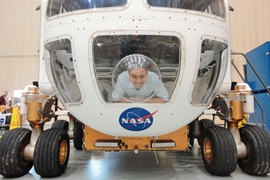If you want to make the long voyage to Mars, you first have to train and rehearse, and MIT alumnus Barret Schlegelmilch SM ’18, MBA ’18 is doing just that. He recently commanded a 45-day practice mission living and working with three other would-be astronauts in a cramped simulated spaceship.
NASA’s Human Exploration Research Analog (HERA) analog mission “departed” last spring for a trip to Phobos, the larger of the two moons of Mars. It was the second of four planned missions to Phobos in the mock spacecraft located at the Johnson Space Center in Houston. The goal is to study the physiological and psychological effects of extended isolation and confinement, team dynamics, and conflict resolution.
While on the mission, Schlegelmilch and three other crew members spent their time just as they would on a real trip to Phobos. They performed experiments, tended plants and shrimp, collected data, maintained equipment, and even communicated with kids in a classroom back home. Once they “arrived” at Phobos, two crew members did a virtual-reality spacewalk, and Schlegelmilch and a flight engineer flew a simulated shuttle craft to the surface.
“That was probably one of the most fun and rewarding things we did,” Schlegelmilch says.
The crew also had to deal with emergencies including fire, loss of pressure, and solar flares, which release a deadly bombardment of radiation. In another scenario, Mission Control secretly told one of the crew to pretend to have a serious injury or heart attack. The others had to draw on their training and the supplies they had on board, along with some advice from a flight surgeon back on Earth (though messages took several minutes each way due to the distance).
The average distance to Mars is about 225 million kilometers, which means that there will be on the order of a 10-minute delay from when any communication is sent and received between ground control on Earth and a crew near Mars. Over the course of the mission, “I saw our crew actually becoming more autonomous and relying on Mission Control less, just because it was so difficult to communicate with them through the time delays,” Schlegelmilch says.
This wasn’t Schlegelmilch’s first experience with working conditions like this. His long-term personal goal has always been spaceflight, so he joined the U.S. Navy after college and served as a diver and officer on nuclear submarines. “I thought subs would be a good analog for the astronaut program. It’s kind of like a spaceship — it’s a self-contained vessel where you carry your own food and make your drinking water and air,” he says. “And you’re not able to just walk outside at the end of the work day; you’re out there for months at a time.”
After his Navy service, Schlegelmilch joined the MIT Leaders for Global Operations (LGO) program, earning an MBA and SM in aeronautics and astronautics in 2018. “I wanted to get a more technical foundation and learn how to translate some of my leadership skills from the Navy into the private sector, and LGO is the perfect fit for doing both of those things,” he says.
The HERA mission was actually more demanding than a submarine voyage in some ways, Schlegelmilch says. Instead of being on a 300-foot-long ship with 150 people, there were just four people crowded into a space half the size of a semi-truck trailer. His crew mates were Ana Mosquera, an astrophysicist and artificial intelligence researcher; Christian Clark, an accomplished cave diver and marine researcher; and Julie Mason, a rocket propulsion engineer at Boeing. The main thing they have in common? “Everyone’s been bitten by the space bug in one way or another,” he says.
Before the mission, the crew underwent extensive psychological testing, and NASA gave them “tool sets” — similar to those taught in LGO for “storming and norming” group development exercises — to help them work more effectively as a team to solve problems. “As a crew, we got along surprisingly well, which I attribute partly to those toolsets,” Schlegelmilch says. “A lot of LGO, and MIT in general, is about how to work with small groups of people on very intense assignments.”
After graduating from MIT, Schlegelmilch went to Blue Origin, a private firm founded by Amazon founder Jeff Bezos to develop technologies to enable private human access to space. After taking a leave for the HERA mission, he returned to Blue Origin and is now head of integrated supply chain for the fluids and mechanical systems of the company’s New Glenn vehicle, a two-piece orbital rocket whose bottom portion autonomously lands itself on a barge at sea for reuse.
As he works on the technology to make space travel more feasible, Schlegelmilch is also working to qualify for the next astronaut class at NASA. Though his first application in 2015 ultimately wasn’t successful, he remains hopeful he’ll have the opportunity to visit space himself.
“I’ll keep applying. I think that’s the goal of a lot of people in this industry,” he says. “There’s a real possibility in our lifetime that spaceflight is something that’s going to be affordable and achievable for average people.”













